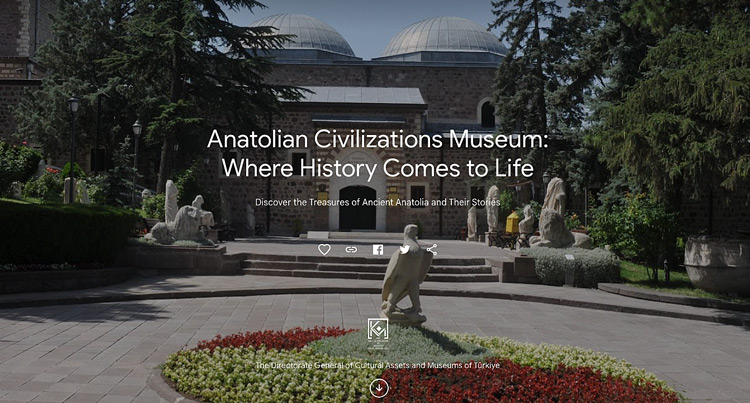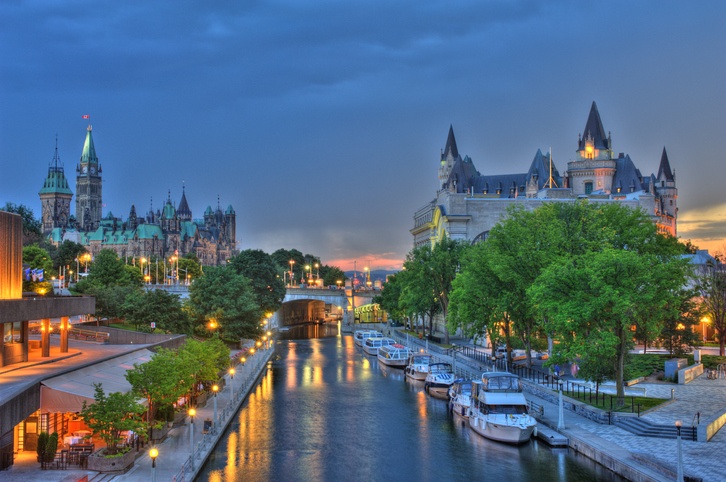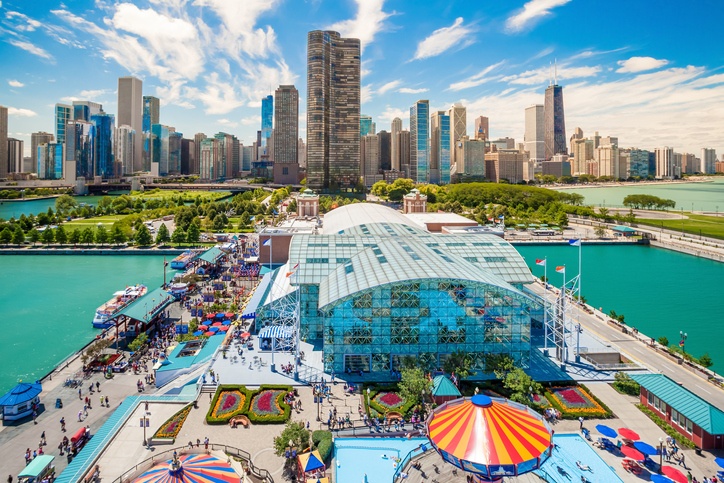A nautical nirvana from sea to land – A boater’s rendezvous with Istanbul, Ankara, and Cappadocia, Turkiye – Part 3
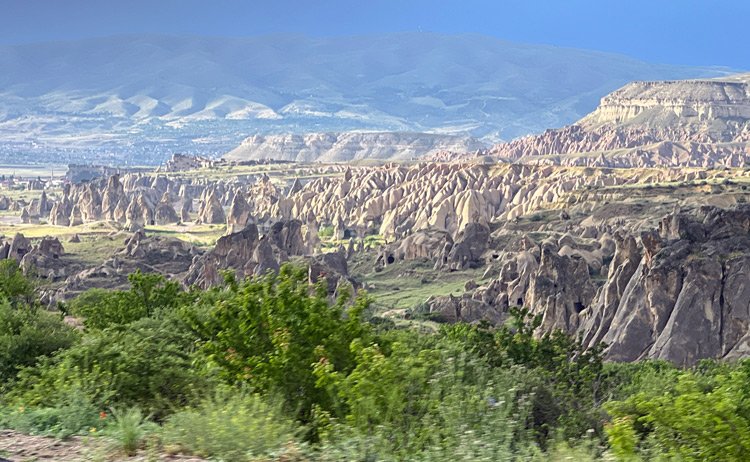
Estimated reading time: 18 minutes – ABR* – Welcome to Part 3 of our rendezvous, this time with Ankara and Cappadocia. After the mesmerizing beauty of the Bosphorus and the vibrant life of Istanbul, we now venture inland to the historical tapestry of Central Anatolia. Here, amidst the windswept plains and rolling hills, our story continues, weaving through the ancient narratives of Ankara and the mystical allure of Cappadocia.
As we leave the coastal splendors behind, we step into a realm where time unfolds in layers, each layer revealing a different epoch of human civilization.
Anatolia, the land where history speaks through its silent stones and echoes in its majestic landscapes
As we traverse from the coastal splendors of Istanbul to the mystical realms of Ankara and Cappadocia, we’re not just moving through space, but time itself. These lands, steeped in history, have witnessed the rise and fall of empires and ancient religions, and the continuous march of humanity in its quest for meaning and mastery over its surroundings.
Our journey is more than a mere geographical shift from the sea to the land. It’s a voyage through the annals of human achievement, a pilgrimage through the layers of time where each stone, ruin, and monument tells a story of human resilience, ingenuity, and, most importantly, our unquenchable thirst for knowledge and understanding of the world we inhabit. So, buckle up as we embark on this thrilling journey to unravel the mysteries and marvels of Central Anatolia.
Central Anatolia
Imagine, if you will, Ankara and the entirety of Central Anatolia around 1700-1200 BC. This region was the heartland of the Hittite civilization, a mighty empire known for its advanced culture and formidable chariots.
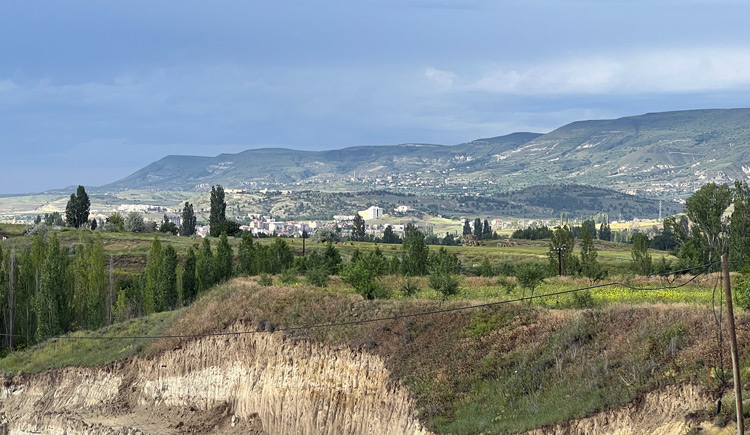
The Hittites fought wars with the Ancient Egyptians over the disputed lands between the two empires that stretched along the eastern Mediterranean coast, as well as several hundred miles east inland between present-day Turkiye and Syria. At the time, the lands of Ancient Egypt stretched east and north along the Mediterranean coast, including present day Gaza, Israel, Lebanon, and part of Syria. Opposing them, the Hittite Empire covered most of central Anatolia and the eastern Mediterranean coast on the north and east, as well as part of Syria.
These mighty empires reigned supreme, until, inevitably, their civilizations eventually fell apart. The Late Bronze Age Collapse was a time of widespread societal collapse between 1200 BC and 1150 BC. It was associated with environmental climate change, mass migration, and destruction of cities. The collapse affected a large area of the Eastern Mediterranean and the ancient Near East.
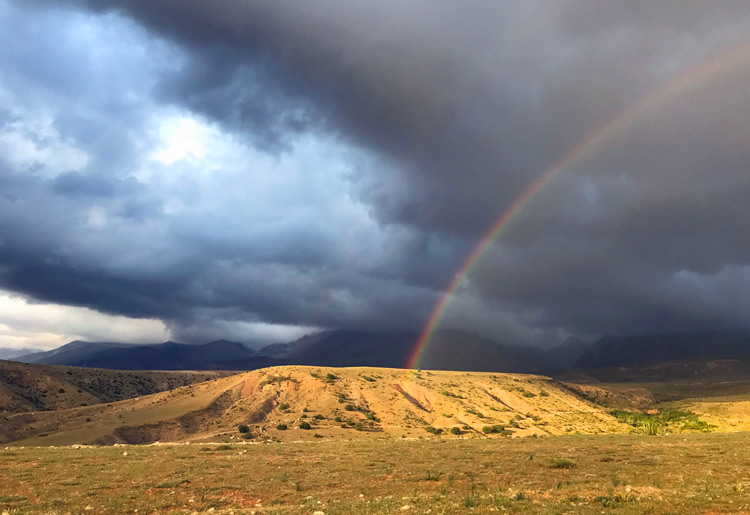
Fast forward to 279 BC, and we encounter the intriguing tale of the Galatians, Celtic warriors who were invited by a local king to come to Anatolia to help fight his wars. Eventually, they formed their own state in this ancient land. These fierce fighters, referenced in the Bible, later embraced Christianity, adding yet another fascinating chapter to the region’s rich tapestry.
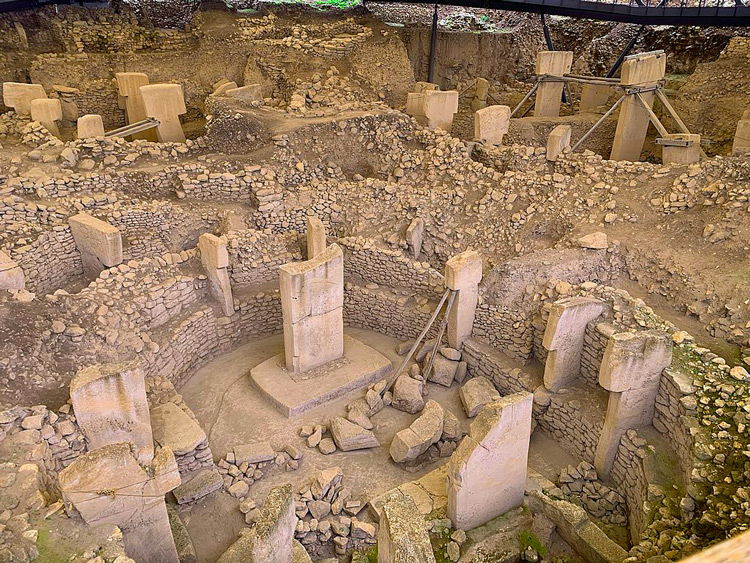
But hold your breath, for the journey through time takes an even more astonishing turn as we delve deeper into Anatolia’s history. If you go further east, there lies Göbekli Tepe, a UNESCO World Heritage Site, and a site that challenges our understanding of human history. Predating Stonehenge by over 6,000 years, this enigmatic sanctuary dates back to an incredible 9600 BC. Its discovery has turned the pages of history, revealing an unknown civilization capable of monumental architecture and complex societal structures, many thousands of years before what was previously thought.
Let this sink in a bit. There we were in 2023 AD in Turkiye, pondering the human history revealed in physical artifacts and structures, evidence of a vibrant civilization in 9600 BC. Long before the Hittites and any other people that we know of. As we traveled through these ancient landscapes, it was almost surreal to grasp the depth of history beneath our feet.
From the Hittite chariots thundering across the Anatolian plains to the mystical rituals of Göbekli Tepe, we were about to explore a land that has been a cradle of civilizations, a crossroads of cultures and religions, and a treasure trove of human heritage.
Think about it, if you are visiting Turkiye and just stay in the wonderful coastal regions, when will you get another chance to get that close to these enchanting lands, parts of which go back almost 12,000 years, even before Göbekli Tepe, and waiting for more discoveries? To us, passing up the opportunity to travel to the interior of Anatolia, even if it was just to a small portion, was simply not an option. Anatolia, where each stone, each ruin, and each landscape tells a story of humanity’s endless quest for meaning, survival, and beauty.
Ankara: A confluence of history and diplomacy in the heart of Anatolia
Our next stop was Ankara, the capital of Türkiye, cradled in the heart of Central Anatolia. Steeped in history that reaches back to the Bronze Age, this city is a treasure trove of the past. While it may not draw as many tourists as the famed destinations of Istanbul or the picturesque Turkish coasts, Ankara holds its own as a significant hub. Frequented by a myriad of domestic and international politicians and diplomats, it stands as a crossroads of global diplomacy and history.
The very best of Ankara, the capital city of Turkiye
Eat more in Ankara
Skip Ankara, and you’ll forgo an unparalleled museum experience
Contrary to popular belief, King Midas was not merely a mythical figure. While tales of his golden touch and donkey ears fall into the realm of legend, he genuinely reigned over Phrygia around 725 to 675 BCE. Midas’ actual tomb was unearthed amidst royal graves near Gordium, in central Anatolia. When archaeologists delved into it in the 1950s, they found it to be the world’s oldest surviving wooden structure, adding a layer of historical truth to the legendary king’s story.
You can marvel at the artifacts King Midas left behind when you visit the Museum of Anatolian Civilizations, which houses these and many other exhibits dating back to 8000 BCE. This is one of those rare museums where you’re allowed to stand just a few feet away from the glass panels, bringing you intimately close to these exquisitely preserved antiquities.
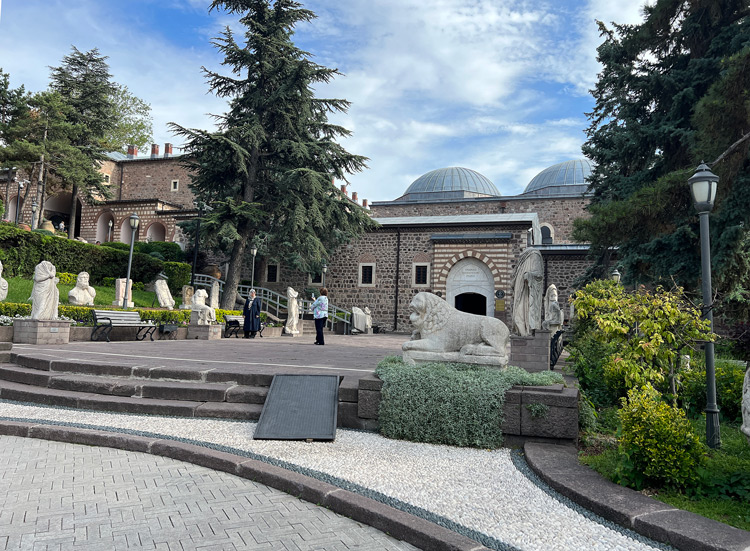
Nestled in the heart of Ankara, the Museum of Anatolian Civilizations is a portal to ancient worlds. This exceptional museum is not just a mere repository of artifacts, but a storyteller of ancient civilizations. It offers a journey through time, making it an absolute must-visit destination for every history enthusiast.
A Walk Through Time
The museum, housed in a beautifully restored Ottoman building near the Ankara Citadel, stands as a testament to the Central Anatolian region’s rich and diverse heritage. Its location in the Atpazarı area, once bustling with traders and travelers, now echoes with the whispers of history.
As you step into the museum, you are transported back to the very dawn of civilization in Anatolia. Visitors are gently whisked away into a world that once was. The museum’s setting, in a former bazaar and caravanserai, adds to the allure, enveloping guests in a sense of historical reverence.
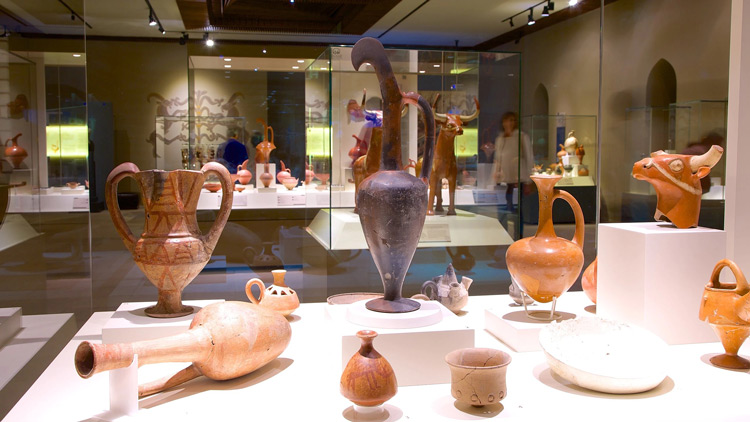
The museum unfolds the story of Anatolia from the Paleolithic era, dating back approximately 8000 BCE, to the Roman period. Each exhibit is thoughtfully arranged, allowing visitors to meander through time at their own pace.
The Treasures of the Hittites and Beyond
One of the museum’s highlights is its unparalleled collection of Hittite artifacts, from the empire that reigned between 1700-1200 BCE. The Hittites, known for their advanced society and sophisticated art, have left behind an indelible mark on Anatolia’s history. The museum showcases relics from Hattusa, the Hittite capital, including ceremonial objects, intricate sculptures, and cuneiform tablets, revealing insights into their daily life, beliefs, and administrative systems.
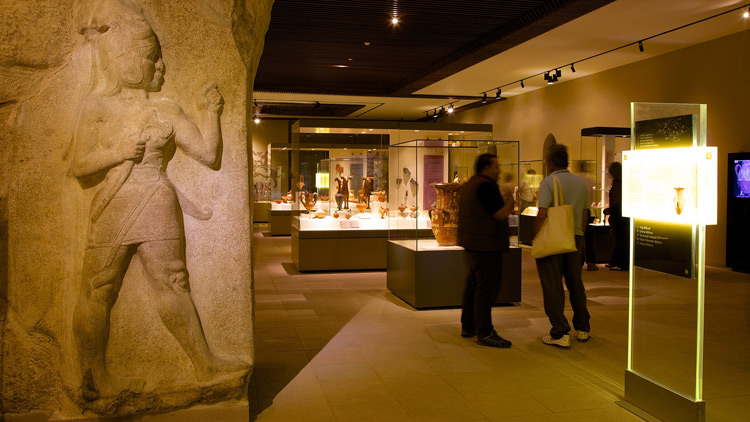
The journey continues through the Bronze Age, showcasing the Urartian civilization (around 860-590 BCE), known for their mastery of metalwork and fortification techniques.
A Unique Window into Neolithic Life
Another crown jewel of the museum is its exhibit on Çatalhöyük, one of the earliest urban centers in the world, dating back to around 7500 BCE. This Neolithic site provides an extraordinary glimpse into early human settlement and social organization. The artifacts, including wall paintings, obsidian tools, and figurines, offer a rare window into the lives of our earliest ancestors.
It’s a bucket list destination
What sets the Museum of Anatolian Civilizations apart is not just its extensive collection but the story it tells of human resilience, innovation, and artistry. It’s a place where history comes alive, where every artifact has a tale to whisper, inviting visitors to listen and learn.
The museum’s ability to encapsulate the essence of civilizations long gone makes it a treasure trove for both history buffs and casual tourists. It’s not just about viewing relics; it’s about understanding our collective past, the rise and fall of empires, and the evolution of societies.
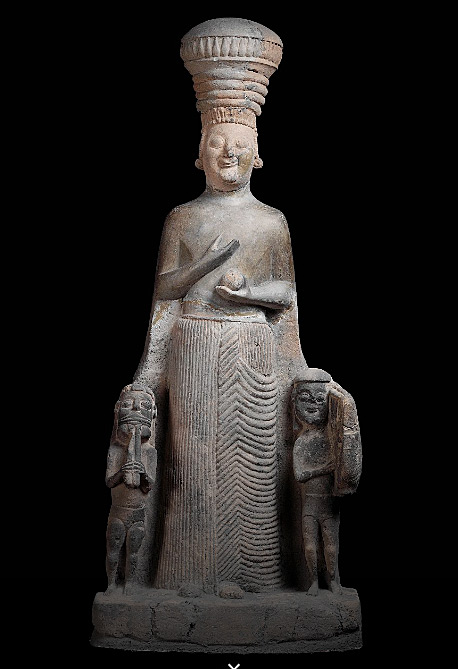
The Museum of Anatolian Civilizations is more than a museum; it’s a journey through time, a celebration of human history, and a testament to Anatolia’s central role in the tapestry of human civilization. Its comprehensive narrative of ancient peoples and cultures, presented with such depth and care, makes it an essential destination for anyone looking to comprehend the vastness of human history.
As you leave the museum, you carry with you not just memories of a visit but a profound connection to the past. The Museum of Anatolian Civilizations is indeed a bucket list destination, offering an unparalleled experience that enriches the mind and soul.
Timeless Elegance at Divan Çukurhan Hotel
We wanted to stay near the Museum of Anatolian Civilizations so that we could spend at least half a day there.
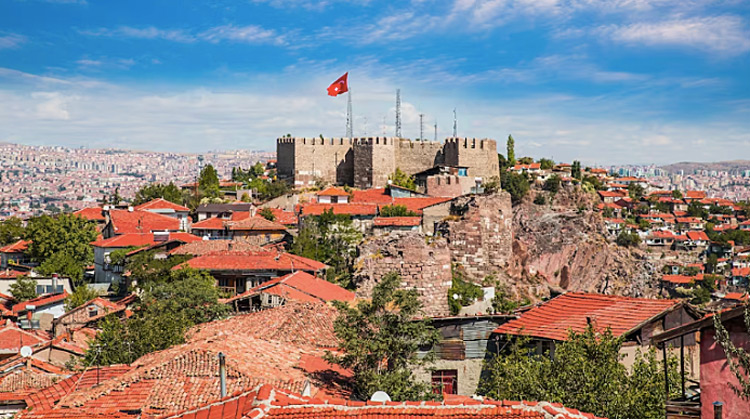
Nestled across from the Ankara Citadel on a steep hill, a part of the old town and just a whisper away from the Museum of Anatolian Civilizations lies the Divan Çukurhan Hotel – a place where history and luxury intertwine, offering a stay that is as enchanting as it is steeped in the past.
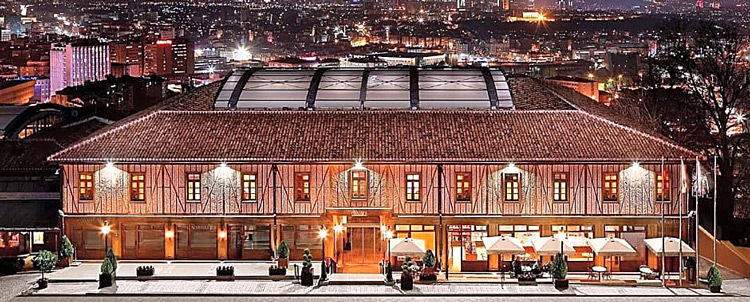
Gateway to bygone eras
Upon arrival, the Divan Çukurhan greets you with its striking façade, a testament to its origins in the 16th century. As you step through its doors, you’re not just entering a hotel, you’re stepping into a narrative that has been unfolding for centuries. Originally a caravanserai (see our “2 Things I Learned” section below), a roadside inn for weary Silk Road travelers, Çukurhan has been meticulously restored, transforming it into a boutique hotel that breathes new life into its ancient stones. We simply loved it. (In the interest of full transparency, we have not received any financial compensation or special accommodation for covering this wonderful hotel.)
Where History Meets Luxury
Each corridor and room in the Divan Çukurhan whispers tales of yesteryears, with the preservation of original features like stone walls and wooden beams. Yet, these historical whispers are harmoniously blended with the comforts of modern luxury.
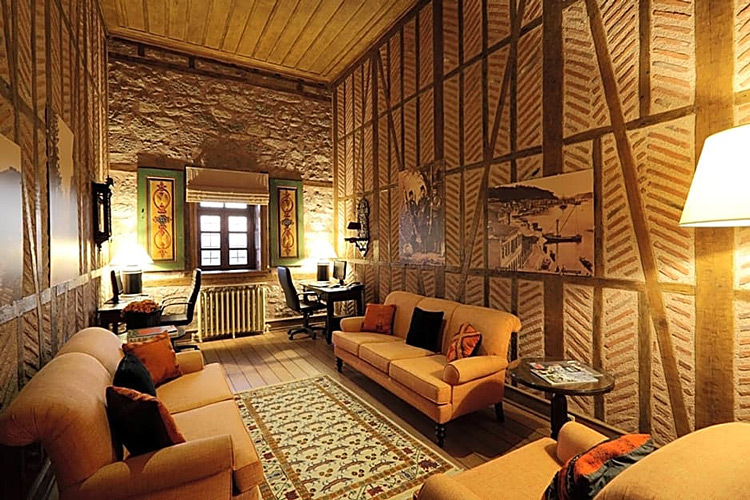
The rooms, each uniquely designed, offer a fusion of traditional Turkish and contemporary styles. High ceilings, elegant furnishings, plush linens, and pillow menus speak of modern luxury, while the subtle architectural details remind you of the building’s historical significance.
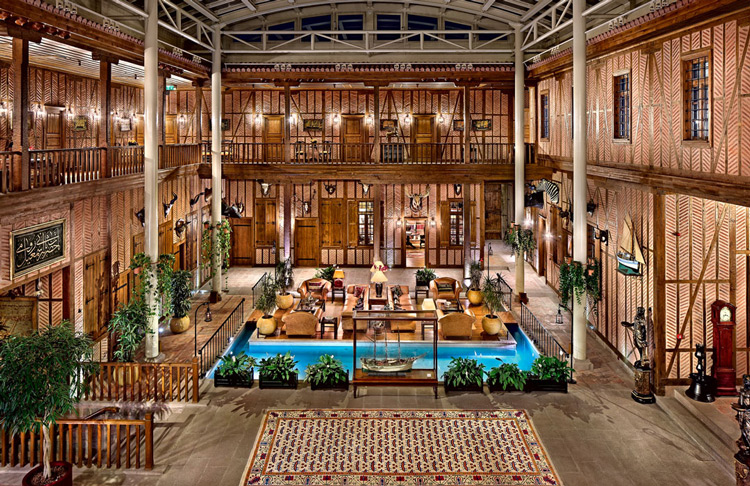
The culinary experience at Divan Çukurhan is nothing short of exceptional. The hotel’s restaurant serves an array of dishes that are as much a feast for the palate as they are for the eyes. Turkish and international cuisines are prepared with fresh, local ingredients, and each meal is a reflection of Turkey’s rich culinary heritage. Dining under the softly lit ambiance of the caravanserai’s courtyard, one can’t help but feel a part of history.
The hotel’s location is ideal for travelers eager to immerse themselves in Ankara’s cultural tapestry. Our favorite, the Museum of Anatolian Civilizations, is just below the hotel and reachable with a 5-minute walk.
What truly sets Divan Çukurhan apart is its impeccable service. The staff, attentive yet unobtrusive, ensures that every aspect of your stay is perfect. It’s this fusion of exceptional service, historical ambiance, and modern comfort that creates an experience beyond mere accommodation.
A Central Anatolian night under the stars
As night falls, the rooftop terrace offers a panoramic view of Ankara’s skyline – a beautiful juxtaposition of the old and the new. It’s here, under the starlit sky, that the true magic of Çukurhan comes alive. The soft hum of the city, mixed with the gentle rustle of the evening breeze, creates a melody that resonates with the soul.
As you depart from the Divan Çukurhan, you carry with you more than just memories of a luxurious stay; you take a deeper understanding of Turkey’s rich heritage and a longing to return. The Divan Çukurhan is not just a hotel; it’s a journey through time, a sanctuary of elegance and history, and a must-stay for anyone traveling to Ankara.
Cappadocia here we come, by bus
Now that we’d spent a couple of delightful days in Ankara, it was time to venture into a realm of enchantment, another one of Turkiye’s 21 UNESCO World Heritage Sites. As we set our course for Cappadocia, let’s take a moment to savor the journey – after all, getting there is part of the adventure.
Unfortunately, those hoping for a quick hop from Ankara to Cappadocia by air will find themselves a bit detoured. The absence of direct regional flights means that if you choose to fly, Turkish Airlines will reroute you back to Istanbul or another western hub. After an 8-hour sojourn, including a stopover, you’ll finally land in Nevşehir, the gateway to the magical Cappadocia region. This somewhat circuitous route by air, interestingly, might be why Ankara doesn’t reap the benefits of the tourist flow heading to Cappadocia.
So, embracing the road less traveled by foreign tourists, we opted for a 3-hour luxury bus ride (no bathrooms) from Ankara to Nevşehir. Turkish intercity buses, especially Kamil Koc bus lines, are very pleasant, offering comfort and scenic views, but the trade-off is almost an entire day spent traveling to reach our unique accommodation in Göreme.
As we traverse the scenic routes of Central Anatolia, the landscape undergoes a dramatic transformation. The dense urban fabric gradually yields to undulating mountains, hills and sprawling, picturesque valleys. Eventually, the enchanting realm of Cappadocia reveals itself. Arriving in Göreme (UNESCO World Heritage Site-Göreme National Park and the Rock Sites of Cappadocia), it’s like entering a different dimension. This quaint town, cradled amidst the iconic “fairy chimneys” – towering, cone-shaped rock formations – stands as a quintessential symbol of Cappadocia.
Cave hotels
Our accommodation for the night? A captivating cave hotel, either hewn directly into these fairy chimneys or constructed to mimic their form, blending rustic allure with contemporary comforts. Staying in a cave hotel is an extraordinary experience. The cool, stone walls and gently arched interiors are not just architectural features; they narrate tales of ancient civilizations and early Christians who sought sanctuary within these natural abodes.
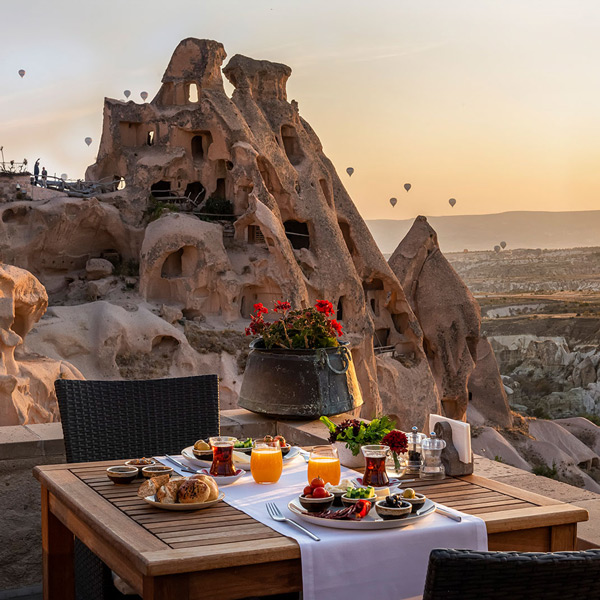
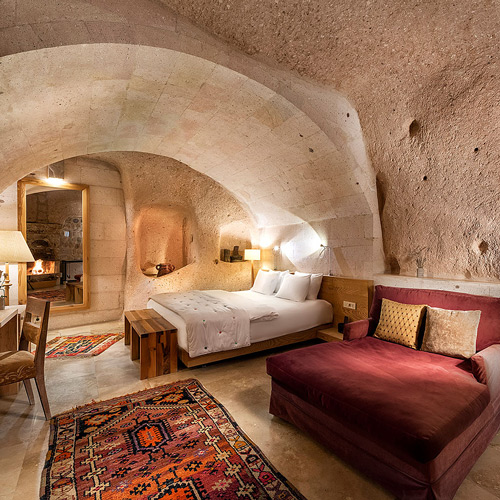
But Cappadocia offers more than its unique lodgings; it’s a living, open-air museum. A landscape carved out by millions of years of volcanic activity and meticulously sculpted by both nature and human endeavor over countless centuries.
Most popular activity, hot air balloon rides
The next day, an early start – think 4 am – sets the stage for the quintessential Cappadocian experience: a hot air balloon ride at dawn. As daylight breaks, the sky transforms into a canvas painted with a multitude of balloons. Drifting above this ethereal landscape, with its deep valleys and intricate rock formations, is an indescribable moment, almost beyond the grasp of words.
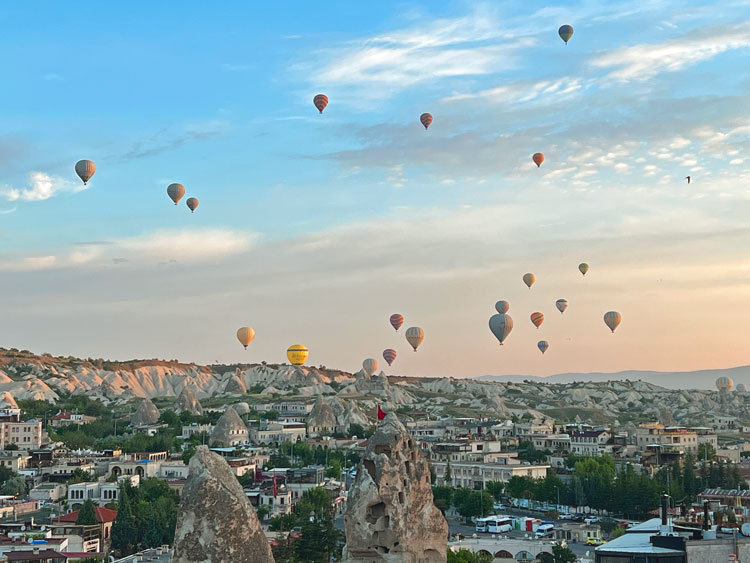
It’s known that some tourists opt for overnight flights, arriving just in time for the balloon ride, only to return to Istanbul the same day. To them, I say: you’ve experienced a breathtaking balloon ride, but you’ve only skimmed the surface of Cappadocia. This region deserves at least 3-4 days of exploration to truly appreciate its majesty. From its historical richness to its natural wonders, Cappadocia is not a place to be rushed; it’s a destination to be savored, where every corner holds a new discovery.
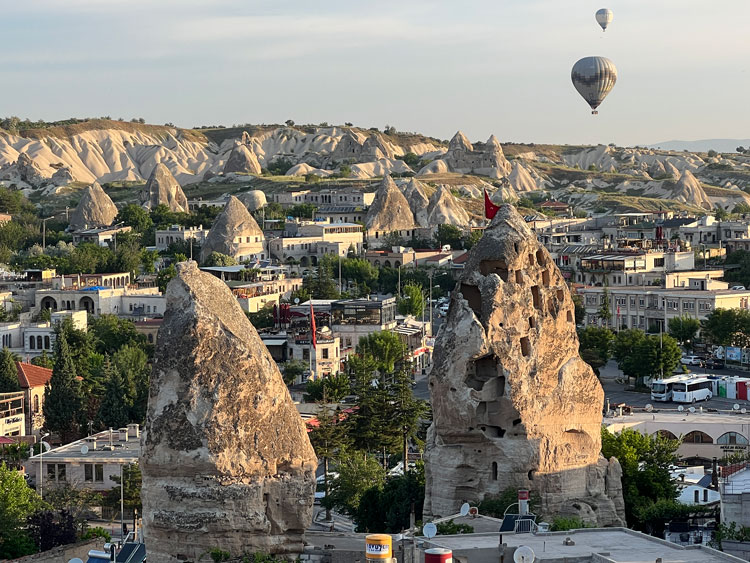
Your hotel, along with local travel agencies, is exceptionally well-organized and offers private or group day tours: the Green Tour and the Red Tour. We highly recommend taking both to get the most out of your Cappadocia experience. If you’re constrained to a 2-3 day visit, these tours are the quickest way to see and savor the essence of the Cappadocia region.
In addition to these tours, there are exhilarating quad bike adventures (four-wheel drive vehicles designed for off-road experiences) and Jeep safaris, offering a more adrenaline-fueled exploration of the landscape. For a more serene experience, horseback rides are available, featuring the indigenous horses of the region. These horses are a significant part of Cappadocia’s charm, deeply intertwined with the area’s history and culture.
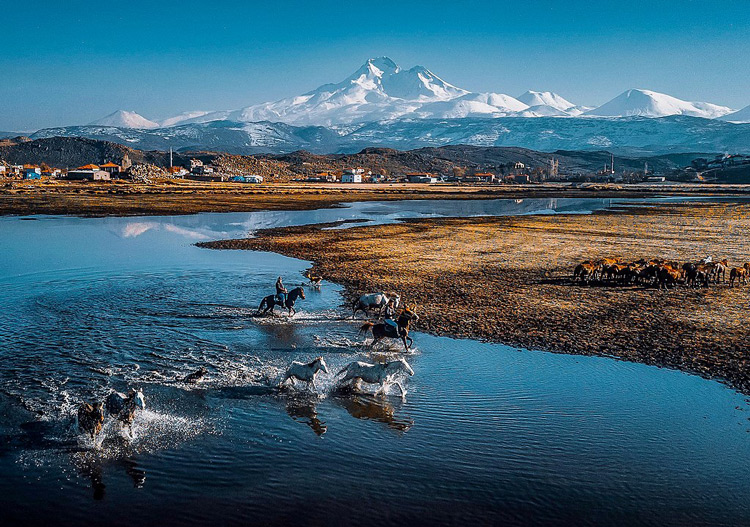
Speaking of Cappadocia’s name, it holds a story in itself. The term ‘Cappadocia’ is believed to have been derived from the ancient Persian or Assyrian word ‘Katpatuka,’ which means ‘the land of beautiful horses.’ The region’s historical association with these majestic animals dates back centuries. The horses of Cappadocia, known for their strength and endurance, played a crucial role in the daily life and warfare of ancient communities here. Today, horseback riding through the valleys and fairy chimneys offers a unique way to connect with the region’s history and natural beauty.
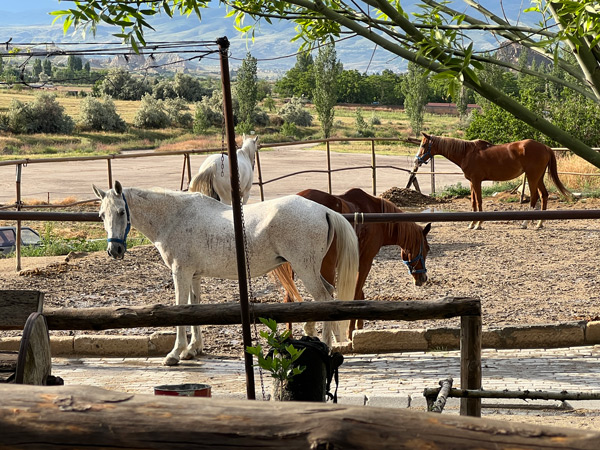
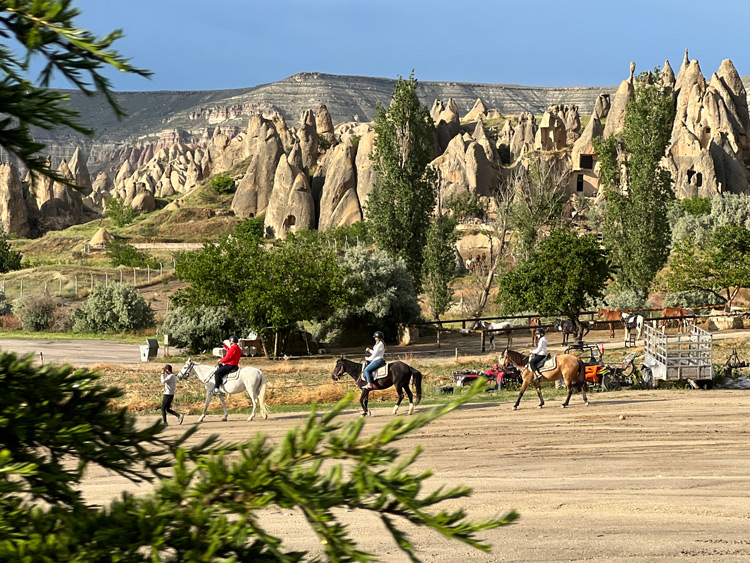
Cappadocia, thus, is not just a geographical marvel; it’s a historical tapestry woven with stories of civilizations, natural wonders, and the enduring legacy of its ‘beautiful horses.’ Each activity, whether it’s a guided tour, a rugged off-road adventure, or a tranquil horseback ride, offers a different perspective of this unique and enchanting landscape.
The hidden world beneath Cappadocia: Unearthing underground cities
Spanning approximately 5,000 square miles, the Cappadocia region is vast, stretching across central Anatolia and encompassing a unique geological and historical landscape.
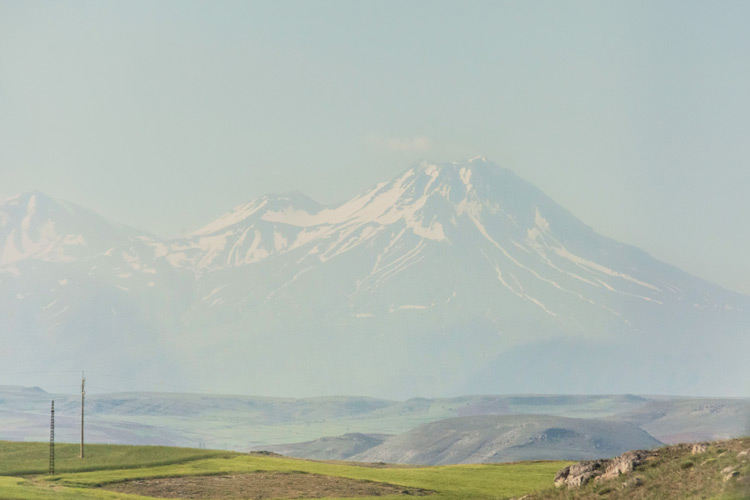
Delving deeper into the wonders of Cappadocia, one of its most intriguing aspects is the network of underground cities, carved deep into the earth. While only a handful, like Derinkuyu, Kaymaklı, and Ozkonak (a much smaller version), are open to the public, it is believed that there could be hundreds more awaiting discovery beneath the region’s rugged terrain.
A portal to ancient ingenuity and survival
The true history of these subterranean cities is as fascinating as it is mysterious. They date back to the times of the Hittites, around 15th century BCE, and were expanded and extensively used by early Christians in the 1st century as hiding spots from Roman persecution. These cities are marvels of ancient engineering, complete with ventilation shafts, living quarters, chapels, stables, and communal areas.
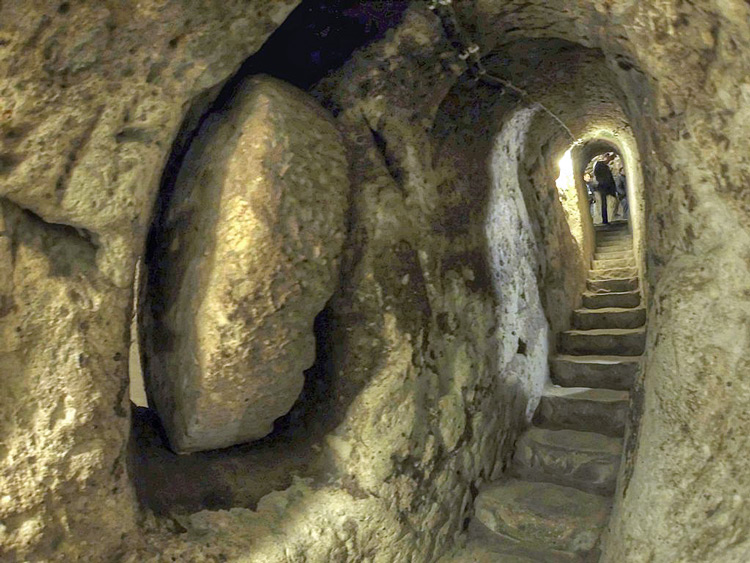
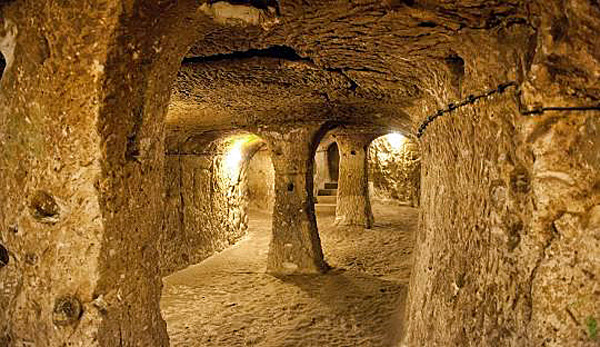
Derinkuyu, the largest of these discovered cities, plunges approximately 85 meters (about 280 feet) into the earth. It could accommodate around 20,000 people along with their livestock and food stores and was five levels or stories deep. Its intricate design includes a labyrinth of tunnels, discrete entrances, and strategic air shafts, alluding to a skilled community that sought refuge and safety in the depths of the earth.
The enduring mysteries of Cappadocia
Exploring these underground cities is akin to stepping into a different world, one where entire communities lived, worked, and thrived beneath the surface. The reasons for their construction are as varied as the legends surrounding them. Some believe they were built to protect the inhabitants from invading armies, while others suggest they were a response to the harsh climatic conditions of the region.
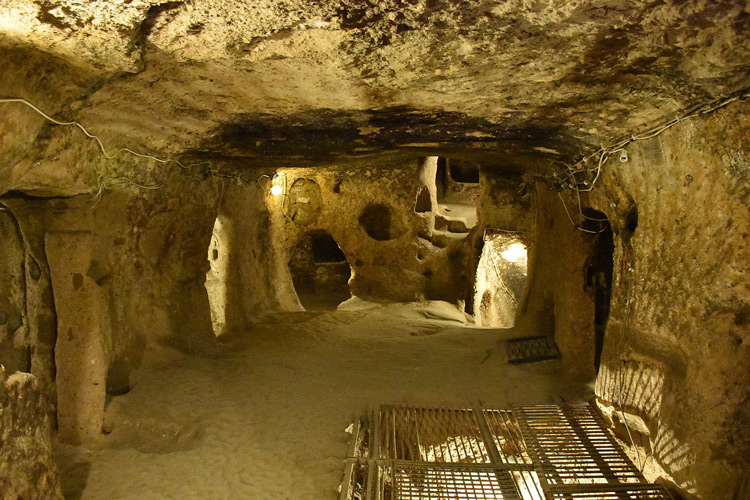
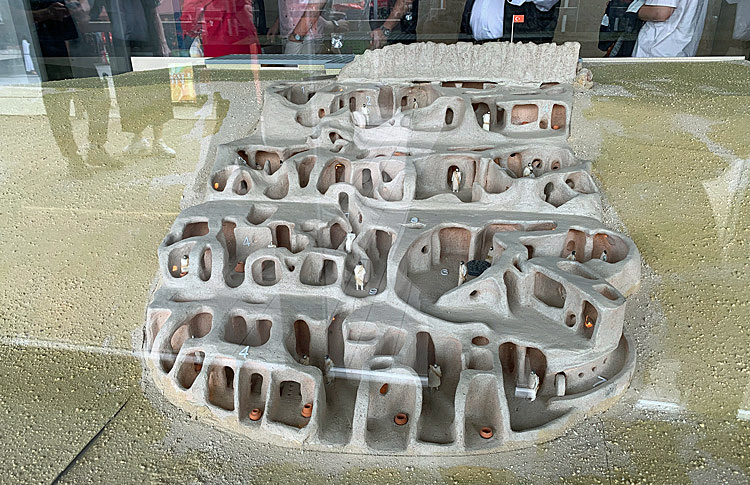
Despite centuries of research and exploration, the underground cities of Cappadocia retain an air of mystery. Each corner of these subterranean complexes tells a story of resilience, innovation, and survival. As archaeologists continue to unearth more about these cities, we are offered a glimpse into a chapter of human history that challenges our understanding of ancient civilizations.
The Cappadocia region, with its sweeping landscapes above and its hidden cities below, serves as a testament to the ingenuity and spirit of its ancient inhabitants. For the modern traveler, it’s an invitation to uncover a world that has long been buried under layers of history and time.
Well, that’s it for now. Stay well. I hope to say hello to you if you spot my boat, Life’s AOK. I bid you Fair Winds and Following Seas.
Cover photo: Central Anatolia’s Cappadocia Region. Photo by TripsOfDiscovery.com
2 things I learned
Anatolian caravanserais, also known as ‘hans’ in Turkish
They are a fascinating aspect of the historical and architectural heritage of Turkey. These structures played a crucial role in the trade and cultural exchanges along the Silk Road and other trade routes that crisscrossed Anatolia. Here are some key points about the Anatolian caravanserai:
- Purpose and Function: Caravanserais were essentially roadside inns designed to provide shelter and safety for travelers, traders, and their animals. They were strategically placed along trade routes to allow for a day’s journey between each, roughly 30-40 kilometers (18-25 miles) apart. These structures provided a secure place to rest, recover, and conduct business.
- Architecture: The architecture of Anatolian caravanserais is notable for its functionality and beauty. Typically, they were built with high, thick walls and a single, large entrance to maximize security. The entrance often faced the direction of the next caravanserai on the route. Inside, they contained an open courtyard, living quarters, stables for animals, storage rooms, and often a mosque. The courtyards were used for loading and unloading goods, as well as for gatherings.
- Historical Period: Many Anatolian caravanserais date from the Seljuk period (11th to 13th centuries), a time when trade along the Silk Road was at its peak. The Seljuk Turks were instrumental in the development and proliferation of caravanserais in Anatolia.
- Cultural Significance: Beyond their practical use, caravanserais were centers of social and economic activity. They facilitated trade and interaction between different cultures and regions. Goods from Asia, Europe, and Africa would be traded, and ideas and cultures would intermingle.
- Preservation and Tourism: Today, many of these caravanserais have been restored and are open to tourists. They offer a glimpse into the past and are a testament to the rich history of trade and cultural exchange in Anatolia. Some have been converted into museums or hotels, providing a unique historical experience. The Divan Çukurhan Hotel in Ankara, that we stayed at and discussed above, is a revitalized Han.
- Famous Examples: Some of the most well-known Anatolian caravanserais include the Sultanhani Caravanserai in Aksaray, which is one of the largest and best-preserved examples, and the Saruhan Caravanserai near Cappadocia.
Anatolian caravanserais are not just historical relics; they are monuments to a time when the exchange of goods, ideas, and cultures was a lifeline connecting the East and West. They stand as reminders of the rich heritage and historical significance of the Silk Road in Turkey.
Ankara Citadel goes back to 3rd century BC
Ankara is known to have been inhabited from prehistoric times, but the first settlement around the Ankara Citadel could be dated back to the Galatian (Celtic) Period in the 3rd century BC. The citadel flourished with the expanding residential fabric of the city in the Roman Period, that started with the conquest of Augustus in 25 BC. The region emerged as one of the centers of the town under Byzantine rule in the 4th and 5th centuries AD, when the fortress of the Citadel reached its current shape. The use of collected materials (spolia) gathered from the buildings of previous eras can be seen at the Inner Citadel, both in the fortresses and the residential buildings and mosques.
As Ankara was conquered by Seljuk Sultan Alparslan in 1073 and later by Ottoman Sultan Orhan in 1356, the citadel developed as the administrative center of the town. It also became the social and commercial center, with the construction of prestigious mansions of urban elites and elaborate mosques, fountains, and hans.
Traditional Ankara houses, which form a substantial part of the Ottoman architectural heritage of the Citadel, were built with mud brick and timber. They have wider upper stories, called “saw-teeth,” that project over a smaller first floor, that are typical for Ankara.
The Citadel and its vicinity were devastated after fires in the 19th and early 20th centuries and lost their central role in the city. The building activities of Ankara as the capital of the Turkish Republic also took place outside the historical center during the Republican Period.
The Ankara Municipality has been undertaking urban improvement projects to protect and sustain the Citadel and its vicinity as the most essential historical part of the city.
5 things I recommend
- If you have time, don’t miss the Museum of Anatolian Civilizations in Ankara, Turkey, and consider staying at the Divan Cukurhan in the Ankara Citadel.
- Suggested itinerary for your Ankara visit:
- Day 1: Explore Ankara
- Ankara Citadel (Ankara Kalesi):
- Start your day by visiting the Ankara Citadel, a historic fortress that offers panoramic views of the city. Explore the old walls and take in the picturesque scenery.
- Anıtkabir (Mausoleum of Atatürk):
Head to Anıtkabir, the mausoleum of Mustafa Kemal Atatürk, the founder of modern Turkey. It’s a significant historical and cultural site. - Museum of Anatolian Civilizations:
Visit the Museum of Anatolian Civilizations, which houses a remarkable collection of artifacts from ancient Anatolia. It provides insights into the region’s rich history. - Lunch in Hamamönü:
Enjoy lunch at one of the charming restaurants in Hamamönü, a historic neighborhood with Ottoman-era houses, boutiques, and cafes. - Hacıbayram Mosque and Bazaar:
Explore the Hacıbayram Mosque and the nearby bazaar. You can shop for souvenirs and immerse yourself in the local culture. - Dinner in Kızılay:
Head to Kızılay, Ankara’s city center, for dinner. There are numerous restaurants offering Turkish cuisine and international options.
- Day 2: Explore Antiquities Nearby Ankara
- Hattusa – Hittite Capital (Approximately 3 hours from Ankara):
- Depart early for Hattusa, the ancient capital of the Hittite Empire. Explore the archaeological site, including the city walls, temples, and the Sphinx Gate.
- Alacahöyük (En route to Ankara):
On your way back to Ankara, stop at Alacahöyük, an ancient Hittite site known for its tombs and artifacts. - Lunch in Alacahöyük:
Have lunch at a local restaurant in Alacahöyük. - Boğazkale (Ancient Hattusa) Museum:
Before heading back to Ankara, visit the Boğazkale Museum to see more artifacts from the Hittite period. - Back to Ankara:
Return to Ankara in the late afternoon or early evening.
This two-day itinerary will give you a taste of both Ankara’s historical and cultural attractions and nearby antiquities.
- Set aside 3-4 days to explore Cappadocia and take both the Green and Red tours. You can join group tours or arrange a private tour.
- In Cappadocia, I recommend experiencing the authentic taste of local traditional food and immersing yourself in the rich tradition within the cozy and charming ambiance of an old house. Visit Dibek Restaurant, situated in the heart of Göreme, where you can savor traditional home-cooked dishes. The historical building housing Dibek Restaurant boasts a remarkable 475-year-old history, adding to the unique dining experience.
- Taste the wines of Cappadocia, including the Kocabag and Tursan brands. You can easily find and sample them at MOZAIK in the town center of Goreme.
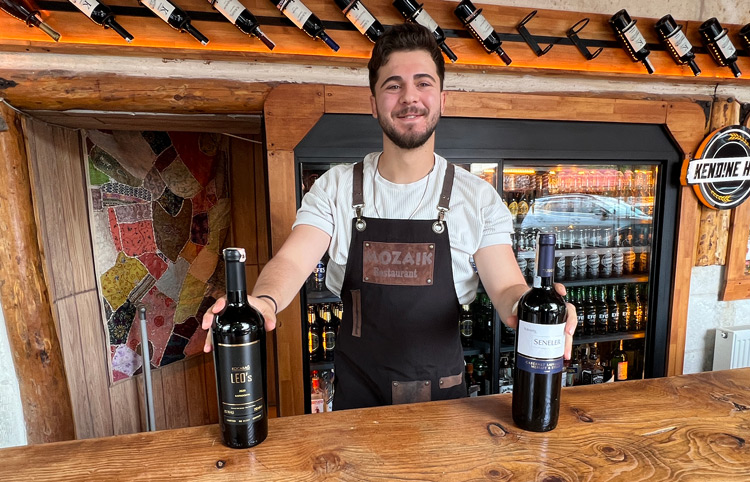
How easy?

*ABR stands for our new series, “A Boater’s Rendezvous.” This series focuses on our voyages to far-flung locations that we wouldn’t dare go to with our boat. Being fair-weather boaters who must see land at all times, we don’t dare to go anywhere and everywhere with our boat, Life’s AOK. So we fly in, rent a boat (with or without a skipper), and enjoy the local waters and camaraderie.
Join us on our journey of discovery of other lands where we fly in and explore the joys of boating. We’re taking you with us, through our blog, “Trips of Discovery.” In this series, we’ll take you to some of the most historic and charming cities of the world and their waters suitable for pleasure boaters like ourselves. Who knows, you might even be inspired to plan your own adventure!
My wife and I hope you’ll be able to join us on the journey, either by boat or by a combination of flying and car. Don’t hesitate to reach out and share your own insights or experiences about the locations we visit. We’d love to hear from you and keep the conversation going! And if not, don’t worry, you can still follow along as an armchair traveler! So sit back, relax, and let’s embark on our Trips of Discovery of other waters.
